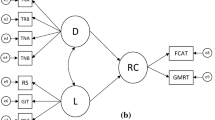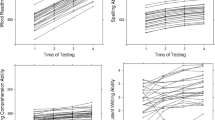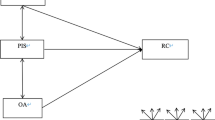Abstract
The relationships among pronunciation level (decoding), verbal level (listening), and accuracy level (reading) were investigated in grades 1 to 6, and for students who are in the advanced phase of decoding. The data collected were used to investigate the validity of the simple view of reading and the causal model of reading achievement which holds that pronunciation level (PL) and verbal level (VL) are the proximal causes of accuracy level (AL). A total of 135 students in grades 1-6 were given measures of nonword decoding, real word decoding, listening, and reading. All of the reliable variation in an indicant of the level of reading ability, AL, could be predicted from an indicant of the level of ability to decode real words, PL, and an indicant of listening level, VL. Furthermore, the strong relationship between pronunciation level, PL, and accuracy level, AL, did not evaporate for the students who had mastered basic decoding skills, as measured by nonword decoding tests. The correlations between pronunciation level, PL, and accuracy level, AL, were high even for students in grades 5 and 6, most of whom probably had progressed beyond the alphabetic phase (phonological recoding). Correlational support was found for the simple view of reading and the causal model which holds that AL is equal to the square root of the product of VL and PL. The above theory and supporting data were interpreted as suggesting that the level of reading accuracy, AL, of students can be improved the most throughout grades 1 to 6 by emphasizing instruction that will improve pronunciation level, or decoding, even for children who have progressed beyond the beginning to read phase which involves learning the alphabetic principal, or phonological recoding.
Similar content being viewed by others
References
Adams, M.J. (1990). Beginning to read: Thinking and learning about print. Cambridge, MA: MIT Press.
Barker, T.A., Torgesen, J.K. & Wagner, R.K. (1992). The role of orthographic processing skills on five different reading tasks, Reading Research Quarterly 27: 334–345.
Calfee, R.C. & Piontkowski, D.C. (1981). The reading diary: Acquisition of decoding, Reading Research Quarterly 16: 346–373.
Carroll, J.B., Davies, P. & Richman, B. (1971). Word frequency book. New York: Houghton Mifflin.
Carver, R.P. (1984). Rauding theory predictions of amount comprehended under different purposes and speed reading conditions, Reading Research Quarterly 19: 205–218.
Carver, R.P. (1985). Measuring absolute amounts of reading comprehension using the rauding rescaling procedure, Journal of Reading Behavior 17: 29–53.
Carver, R.P. (1990a). Reading rate: A review of research and theory. New York: Academic Press.
Carver, R.P. (1990b). Predicting accuracy of comprehension from the relative difficulty of the material, Learning and Individual Differences 2(4): 405–422.
Carver, R.P. (1990c). Rescaling the Degrees of Reading Power test to provide valid scores for selecting materials at the instructional level, Journal of Reading Behavior 22: 1–18.
Carver, R.P. (1991a). Manual for the Computer Assisted Reading Diagnosis. Kanas City, MO: Revrac Publications.
Carver, R.P. (1991b). Using letter-naming speed to diagnose reading disability, Remedial and Special Education 12: 33–43.
Carver, R.P. (1992a). What do standardized tests of reading comprehension measure in terms of efficiency, accuracy and rate?, Reading Research Quarterly 27: 346–359.
Carver, R.P. (1992b). The three factors in reading ability: Reanalysis of a study by Cunningham, Stanovich, and Wilson, Journal of Reading Behavior 24: 173–190.
Carver, R.P. (1993). Merging the simple view of reading with rauding theory, Journal of Reading Behavior 25: 439–455.
Carver, R.P. (1994a). Technical manual for the Computer Assisted Reading Diagnosis. Kansas City, MO: Revrac Publications.
Carver, R.P. (1994b). Manual for the Accuracy Level Test. Kanas City, MO: Revrac Publications.
Carver, R.P. (1997). Reading for one-second, one-minute, or one-year from the perspective of rauding theory, Scientific Studies of Reading 1: 3–44.
Cunningham, A.E. & Stanovich, K.E. (1990). Assessing print exposure and orthographic processing skill in children: A quick measure of reading experience, Journal of Educational Psychology 82: 733–740.
Curtis, M.E. (1980). Development of components of reading skill, Journal of Educational Psychology 72: 656–669.
Daneman, M. (1991). Individual differences in reading skills. In R. Barr, M.L. Kamil, P.B. Mosenthal & P.D. Pearson (eds.), Handbook of reading research, Vol. II (pp. 512–538). New York: Longman.
Dreyer, L.G. & Katz, L. (1992). An examination of ‘the simple view of reading’, Yearbook of the National Reading Conference 41: 169–176.
Ehri, L.C. (1991). Development of the ability to read words. In R. Barr, M.L. Kamil, P.B. Mosenthal & P.D. Pearson (eds.), Handbook of reading research, Vol. II (pp. 383–417). New York: Longman.
Evans, M.A. & Carr, T.H. (1985). Cognitive abilities, conditions of learning, and the early development of reading skill, Reading Research Quarterly 20: 327–350.
Ferguson, G.A. (1959). Statistical analysis in psychology and education. New York: McGraw-Hill.
Frith, U. (1985). Beneath the surface of developmental dyslexia. In K.E. Patterson, J.C. Marshall & M. Coltheart (eds.), Surface dyslexia (pp. 301–330). Hillsdale, NJ: Erlbaum.
Gough, P.B. (1972). One second of reading. In J.F. Kavanagh & I.G. Mattingly (eds.), Language by ear and by eye: The relationship between speech and reading. Cambridge, MA: MIT Press.
Gough, P.B. & Tunmer, W.E. (1986). Decoding, reading, and reading disability, Remedial and Special Education 7: 6–11.
Hoover, W.A. & Gough, P.B. (1990). The simple view of reading, Reading and Writing: An Interdisciplinary Journal 2: 127–160.
Jastak, J.F. & Jastak, S. (1978). Manual for the Wide Range Achievement Test-Revised Edition. Wilmington, DE: Jastak Associates.
Juel, C. (1988). Learning to read and write: A longitudinal study of fifty-four children from first through fourth grade, Journal of Educational Psychology 80: 437–447.
Juel, C., Griffith, P.L. & Gough, P.B. (1986). Acquisition of literacy: A longitudinal study of children in first and second grade, Journal of Educational Psychology 78: 243–255.
Olson, R., Wise, B., Connors, F., Rack, J. & Fulker, D. (1989). Specific deficits in component reading and language skills: Genetic and environmental influence, Journal of Learning Disabilities 22: 339–348.
Perfetti, C.A. (1987). Language, speech, and print: Some asymmetries in the acquisition of literacy. In Horowitz, R. & Samuels, S.J. (eds.), Comprehending oral and written language (pp. 355–369). New York: Academic Press.
Sinatra, G.M. (1990). Convergence of listening and reading processing, Reading Research Quarterly 25: 115–130.
Stanovich, K.E. (1991). Word recognition: Changing perspectives. In R. Barr, M.L. Kamil, P.B. Mosenthal & P.D. Pearson (eds.), Handbook of reading research, Vol. II, New York: Longman.
Stanovich, K.E., Nathan, R.G. & Zolman, J.E. (1988). The developmental lag hypothesis in reading: Longitudinal and matched reading-level comparison, Child Development 59: 71–86.
Stevens, S.S. (1951). Mathematics, measurement, and psychophysics. In S.S. Stevens (ed.), Handbook of experimental psychology (pp. 1–49). New York: Wiley.
Sticht, T.G., Beck, L.J., Hauke, R.N., Kleiman, G.M. & James, J.H. (1974). Auding and reading: A development model. Alexandria, VA: Human Resources Research Organization.
Thorndike, E. & Lorge, I. (1944). Teacher's word book of 30,000 words. New York: Teachers College Columbia University.
Vellutino, F.R. (1991). Introduction to three studies on reading acquisition: Convergent findings on theoretical foundations of code-oriented versus whole-language approaches to reading instruction, Journal of Educational Psychology 83: 437–443.
Vellutino, F.R., Scanlon, D.M., Small, S.G. & Tanzman, M.S. (1991). The linguistic bases of reading ability: Converting written to oral language, Text 11: 99–133.
Author information
Authors and Affiliations
Rights and permissions
About this article
Cite this article
Carver, R.P. Predicting reading level in grades 1 to 6 from listening level and decoding level: Testing theory relevant to the simple view of reading. Reading and Writing 10, 121–154 (1998). https://doi.org/10.1023/A:1007923124312
Issue Date:
DOI: https://doi.org/10.1023/A:1007923124312




